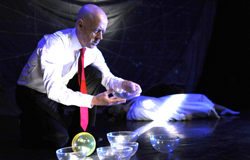The shape of the universe explained through art
Release Date 06 December 2011

Have you ever wondered what shape the universe is, or whether it's even possible to know? Does it have an ‘edge'? Is it infinite?
These, and other cosmic questions, will be answered in a theatrical performance and interactive workshop at the University of Reading on Sunday 11 December. Organisers hope the event will help people make sense of a complex mathematical theorem, the Poincaré Conjecture, that can be used to understand the shape of the universe.
The theatrical performance, called ‘Everything and Nothing', tells the story of the fictional Amelia Earhart, based on the real-life explorer and aviator who disappeared over the Pacific Ocean in 1937, and her attempts to understand the universe she lives in. Amelia and Everyman Explorer, a mathematician and musician, find themselves in the company of an order-obsessed librarian who isn't quite what he seems, in a time-warped universe controlled by an old radio.
Dr Kate Allen, Sculptor and Lecturer in the Department of Art at the University of Reading, and composer Dorothy Ker from the University of Sheffield, have devised the piece as part of ‘The 19th Step' project in collaboration with performers and sound artists to create a thought-provoking and entertaining performance. The project has been funded by the Engineering and Physical Sciences Research Council (EPSRC).
Dr Allen said: "Artists of all backgrounds often look to science for inspiration, and it's well understood, particularly at the University of Reading, that the most cutting-edge advances in knowledge come from the interactions between different academic fields.
"We're hoping that this event will use the dramatic possibilities of theatre and human storytelling to convey some of the greatest cosmic mysteries of all."
Following the show, mathematician and ‘maths busker' Dr Katie Steckles, well-known for entertaining crowds with her mathematical insight, will lead a workshop to explain the science behind 'Everything and Nothing', as well as tell the story of the Poincaré Conjecture and its eventual solution. Incorporating explanation, performance, and audience interaction, the workshop is suitable for all ages, and will end with the opportunity to ask questions about any of the mathematics covered, or other related maths topics.
The performance and workshop is suitable for all ages, and is taking place on Sunday 11th December at 7.00pm, in the Bob Kaley Theatre, Minghella Building, University of Reading.
ENDS
For more information contact Becki Rassell, University of Reading Communications Officer, on 0118 378 8408 or b.rassell@reading.ac.uk.
Notes for editors
The 19th Step Project
Led by composer Dorothy Ker, choreographer Carol Brown, sculptor Kate Allen and mathematician Marcus du Sautoy, The 19th Step is a performance-based research project exploring different ways the ‘languages' of music, dance, sculpture and mathematics can talk to each other. In the context of theatre, the project discovers synergies that cut across discipline boundaries to reveal new ways of understanding space and the shared nature of questions around space.
EPSRC
EPSRC is the main UK government agency for funding research and training in engineering and the physical sciences, investing more than £850 million a year in a broad range of subjects, from mathematics to materials science, and from information technology to structural engineering.
